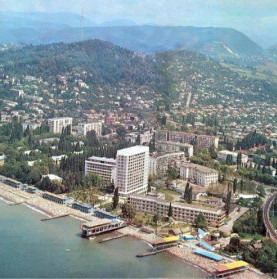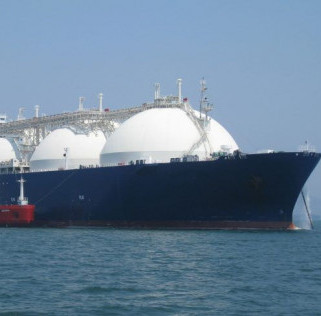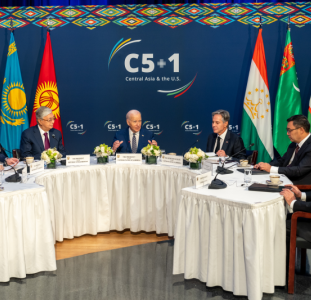Using the anti-terrorist rhetoric, Washington revived Ronald Reagan’s “star wars” concept, launching the technological development and deployment of a national missile defense (NMD) system.
It simultaneously launched an information campaign to appease Russia, keeping in mind this country’s impressive nuclear forces and capability of adequate response to America’s nuclear supremacy. The propaganda was aimed at convincing the Russian government and public that NMD was designed as defense against North Korea, Iran, Libya and Syria.
However, an analysis of the political situation involving NMD, and the geography of its deployment revealed the following:
— first, nations like North Korea and Iran would need bigger scientific and technological potentials and much more developed economies to produce ballistic missiles capable of damaging targets located in the United States. As for terrorists, they seem to have a whole array of simpler and cheaper ways to attack;
— second, judging by the technological requirements to the NMD elements, the system is designed to destroy ballistic missiles employed by the Russian armed forces; and
— third, one look at the US NMD facilities plotted on a map would be enough to see an outlined belt embracing Russia.
The obvious conclusion is that the system is being designed to defend America against Russia’s potential nuclear attack, thus neutralizing Russian nuclear forces and achieving global dominion. Incidentally, this concept is documented in the Pentagon’s official papers.
It is only natural that Russia’s government is taking counter-measures in a bid to “tame American cowboys’ ardor.” For instance, Russia is armed with missiles and nuclear warheads which even now can penetrate a very advanced global ABM system. In addition, new-generation nuclear weapons are being developed, which would seriously jeopardize all the efforts of our overseas “friends.” For example, NMD’s missile attack warning systems have recently failed to register the flight stages of the new-generation missile test-fired by Russia.
It follows from the above that no nation, even as developed as the United States, can hope to build an ABM system today which would guarantee their safety against the state-of-the-art military hardware, especially modern space and missile technologies.
The US also emphasizes European nations’ important roles in its NMD policy.
Washington’s interest in this political play is only natural: using European territories, it can move closer to Russia’s launch-pads at the same time pushing the potential battlefield farther away from its own boundaries. It can also use European nations’ scientific potentials in the space and missile area, and have them share the humongous costs of the state-of-the-art ABM system.
Now what are Europe’s benefits?
First, Europe’s security will directly depend on its American “relative,” since a big part of the NMD facilities is to be deployed in Europe, but controlled from the United States.
Second, the huge financial expenses on the “European umbrella” can lead to an economic crisis in Europe, which would, no doubt, boost America’s economic growth.
Third, the deployment of missile-defense facilities is fraught with environmental problems (FYI, there are plans to install nuclear warheads on interceptor missiles), let alone the possible aftermath of an interception, if one actually happens. That aftermath would physically fall upon Europeans’ heads.
Fourth, the missile-defense facilities will be primary targets to be destroyed, both in a potential armed conflict, and for terrorist attacks.
These four are only a small portion of the problems which will inevitably arise when missile defense facilities are positioned in Europe, as the US plans. America has assigned Europe the role of a missile test-ground, throwing it back into the “cold war” and boosting its own security at Europe’s expense. All the advantages Europe would allegedly enjoy are a bluff. The newly-fledged NATO members like Poland, the Czech Republic, Hungary and some others, seek to gain political weight by participating in the US military programs; still they are no more than puppets in the hands of an experienced puppeteer.
However, as the general technological level rises in the world, more possibilities arise, no doubt, to orchestrate a large-scale terrorist attack, even with the use of mass-destruction weapons. What’s more, America’s actions sometimes promote such possibilities. For instance, detailed schemes of how to create Iraq’s nuclear bomb have been posted on the Internet, with the connivance of the top US military officials (or was it done deliberately?). Work specifications of Zarin chemical weapons production process had appeared earlier.
In addition, due to the past decade’s anti-American moods, small-range missiles are being actively proliferated. These pose a danger for a number of European nations, including Russia, which is a part of the European continent.
In this connection, the Russian government made a proposal to European nations to set up a pan-European non-strategic ABM system, which would promote strategic stability on this continent, and strengthen European security.
The proposal is based on the following ideas:
— a European ABM program must rely on close cooperation of all countries and duly consider their security interests, regardless of their membership in various international organizations and alliances;
—European cooperation under an ABM program must not step up tensions between Europe and countries which could be considered as potential direct or indirect adversaries.
Unlike the US with its egocentric stand on European security, Russia puts forth the concept of broad international cooperation in preventing dangers, including the threats the USA points out to justify its plan to set up its missile-defense bases across Europe.
Therefore, the US global missile-defense plans can have an adverse effect on international security; the deployment of the global system’s facilities in Europe will shatter the existing balance of forces in that region, undermine regional and global stability. Still, Russia advocates new strategic relations and a true partnership with the United States and European nations alike, as well as continued stability in Europe and the world.
Time will show what actually happens. However, the military and political leaders of Russia and NATO would be wise to discus this issue within the Russia-NATO Council framework.









